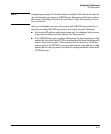
Configuring IP Addressing
IP Configuration
Note
Note
DHCP/Bootp Operation
Overview. DHCP/Bootp is used to provide configuration data from a DHCP
or Bootp server to the switch. This data can be the IP address, subnet mask,
default gateway, Timep Server address, and TFTP server address. If a TFTP
server address is provided, this allows the switch to TFTP a previously saved
configuration file from the TFTP server to the switch. With either DHCP or
Bootp, the servers must be configured prior to the switch being connected to
the network.
The switches covered in this guide are compatible with both DHCP and Bootp
servers.
The DHCP/Bootp Process. Whenever the IP Config parameter in the switch
or in an individual VLAN in the switch is configured to DHCP/Bootp (the
default), or when the switch is rebooted with this configuration:
1. DHCP/Bootp requests are automatically broadcast on the local network.
(The switch sends one type of request to which either a DHCP or Bootp
server can respond.)
2. When a DHCP or Bootp server receives the request, it replies with a
previously configured IP address and subnet mask for the switch. The
switch also receives an IP Gateway address if the server has been config-
ured to provide one. In the case of Bootp, the server must first be
configured with an entry that has the switch’s MAC address. (To determine
the switch’s MAC address, refer to Appendix D, “MAC Address Manage-
ment”.) The switch properly handles replies from either type of server. If
multiple replies are returned, the switch tries to use the first reply.)
If you manually configure default gateway, TTL, TimeP, and/or SNTP param-
eters on the switch, it ignores any values received for the same parameters via
DHCP or Bootp.
If the switch is initially configured for DHCP/Bootp operation (the default),
or if it reboots with this configuration, it begins sending request packets on
the network. If the switch does not receive a reply to its DHCP/Bootp requests,
it continues to periodically send request packets, but with decreasing fre-
quency. Thus, if a DHCP or Bootp server is not available or accessible to the
switch when DHCP/Bootp is first configured, the switch may not immediately
receive the desired configuration. After verifying that the server has become
accessible to the switch, reboot the switch to re-start the process immediately.
8-12


















